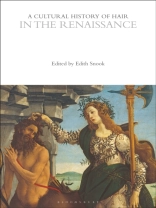In the period 1450 to 1650 in Europe, hair was braided, curled, shaped, cut, colored, covered, decorated, supplemented, removed, and reused in magic, courtship, and art, amongst other things. On the body, Renaissance men and women often considered hair a signifier of order and civility. Hair style and the head coverings worn by many throughout the period marked not only the wearer”s engagement with fashion, but also moral, religious, social, and political beliefs. Hair established individuals” positions in the period”s social hierarchy and signified class, gender, and racial identities, as well as distinctions of age and marital and professional status. Such a meaningful part of the body, however, could also be disorderly, when it grew where it wasn”t supposed to or transgressed the body”s boundaries by being wild, uncovered, unpinned, or uncut. A natural material with cultural import, hair weaves together the Renaissance histories of fashion, politics, religion, gender, science, medicine, art, literature, and material culture.
A necessarily interdisciplinary study,
A Cultural History of Hair in the Renaissance explores the multiple meanings of hair, as well as the ideas and practices it inspired. Separate chapters contemplate Religion and Ritualized Belief, Self and Society, Fashion and Adornment, Production and Practice, Health and Hygiene, Sexuality and Gender, Race and Ethnicity, Class and Social Status, and Cultural Representations.
Edith Snook
A Cultural History of Hair in the Renaissance [EPUB ebook]
A Cultural History of Hair in the Renaissance [EPUB ebook]
ซื้อ eBook เล่มนี้และรับฟรีอีก 1 เล่ม!
รูป EPUB ● หน้า 232 ● ISBN 9781350122802 ● บรรณาธิการ Edith Snook ● สำนักพิมพ์ Bloomsbury Publishing ● การตีพิมพ์ 2020 ● ที่สามารถดาวน์โหลดได้ 3 ครั้ง ● เงินตรา EUR ● ID 7682423 ● ป้องกันการคัดลอก Adobe DRM
ต้องใช้เครื่องอ่านหนังสืออิเล็กทรอนิกส์ที่มีความสามารถ DRM












